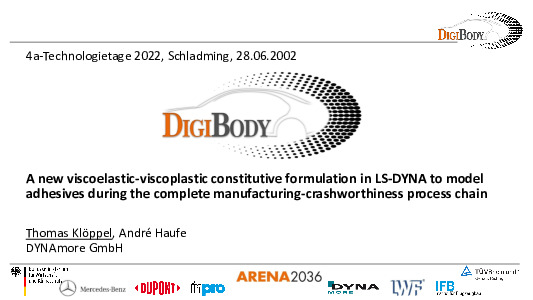The new constitutive model *MAT_GENERALIZED_ADHESIVE_CURING / *MAT_307 in LS-DYNA is introduced in this contribution. It has been developed within the public funded joint research project “DigiBody” and is tailored to model adhesive materials throughout the complete manufacturing-crashworthiness process chain. This implies that the material must be able to capture, on the one hand, important effects resulting from the manufacturing process such as the Δ𝛼-problem and viscous fingering and, on the other hand, the rather complex plasticity and damage behavior of fully or partially cured adhesives. Material *MAT_307 features a modular and flexible input format. For example, several options are available to define the underlying temperature dependent evolution equations for the curing kinetics. The effect of current degree of cure and temperature on the viscoelastic master curves, which are defined by the Prony series expansion, is realized with different shifting operations. The implemented non-associated plasticity model as well as the mechanisms for damage evolution extend the formulation of *MAT_TAPO by temperature and degree of cure dependences. Additionally, an empirical damage mechanism has been implemented to account for the reduction of the adhesive area due to viscous fingering. Different examples are presented that demonstrate the effects of the individual material options and validate the implementation. The material could successfully be calibrated for different tensile and shear tests in a wide range of temperatures and for different degrees of cure.

